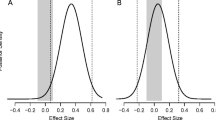Abstract
Bayesian prior probabilities have an important place in probabilistic and statistical methods. In spite of this fact, the analysis of where these priors come from and how they are formed has received little attention. It is reasonable to excuse the lack, in the foundational literature, of detailed psychological theory of what are the mechanisms by which prior probabilities are formed. But it is less excusable that there is an almost total absence of a detailed discussion of the highly differentiating nature of past experience in forming a prior. The focus here is on what kind of account, even if necessarily schematic, can be given about the psychological mechanisms back of the formation of Bayesian priors. The last section examines a detailed experiment relevant to how priors are learned.
Similar content being viewed by others
References
de Finetti B. (1974). Theory of probability, Vol I. John Wiley & Sons, Ltd, London
Estes W.K. (1950). Toward a statistical theory of learning. Psychological Review 57, 94–107
Hume D. (1739). A treatise on human nature. John Noon, London
James W. (1890). Principles of psychology, Vol I. Henry Holt & Company, New York
Murphy G.L. (2002). The big book of concepts. MIT Press, Cambridge, MA
Ramsey, F. P. (1926/1931). Truth and probability. In R. Braithwaite (Ed.), The foundations of mathematics. London: Kegan Paul, Trench, Trubner & Co.
Savage L.J. (1954). The foundations of statistics. John Wiley & Sons, Inc., New York
Savage L.J. (1971). Elicitation of personal probabilities and expectations. Journal of the American Statistical Association 66, 565–614
Siegelmann H.T., Sontag E.D. (1995). On the computational power of neural nets. Journal of Computer and System Sciences 50, 132–150
Suppes P. (1956). The role of subjective probability and utility in decision-making. Proceedings of the Third Berkeley Symposium on Mathematical Statistics and Probability 1954–1955 5, 61–73
Suppes P. (1959). A linear model for a continuum of responses. In: Bush R.R., Estes W.K. (eds). Studies in mathematical learning theory. Stanford University Press, Stanford, CA, pp. 400–414
Suppes P. (1960). Stimulus-sampling theory for a continuum of responses. In: Arrow K.J., Karlin S., Suppes P. (eds). Mathematical methods in the social sciences. Stanford University Press, Stanford, CA, pp. 348–365
Suppes P. (2002). Representation and invariance of scientific structures. CSLI Publications, Stanford, CA
Suppes P., Atkinson R.C. (1960). Markov learning models for multiperson interactions. Stanford University Press, Stanford
Suppes P., Beziau J.-Y. (2004). Semantic computations of truth based on associations already learned. Journal of Applied Logic 2(4): 457–467
Suppes P., Frankmann R.W. (1961). Test of stimulus sampling theory for a continuum of responses with unimodal noncontingent determinate reinforcement. Journal of Experimental Psychology 61, 122–132
Suppes P., Han B., Epelboim J., Lu Z.-L. (1999a). Invariance between subjects of brain wave representations of language. Proceedings National Academy of Sciences 96, 12953–12958
Suppes P., Han B., Epelboim J., Lu Z.-L. (1999b). Invariance of brain-wave representations of simple visual images and their names. Proceedings National Academy of Sciences 96, 14658–14663
Suppes P., Lu Z.-L., Han B. (1997). Brain wave recognition of words. Proceedings National Academy of Sciences 94, 14965–14969
Suppes P., Rouanet H. (1964). A simple discrimination experiment with a continuum of responses. In: Atkinson R.C. (eds). Studies in mathematical psychology. Stanford University Press, Stanford, CA, pp. 317–357
Suppes P., Rouanet H., Levine M., Frankmann R.W. (1964). Empirical comparison of models for a continuum of responses with noncontingent bimodal reinforcement. In: Atkinson R.C. (eds). Studies in mathematical psychology. Stanford University Press, Stanford, CA, pp. 358–379
Author information
Authors and Affiliations
Corresponding author
Rights and permissions
About this article
Cite this article
Suppes, P. Where do Bayesian priors come from?. Synthese 156, 441–471 (2007). https://doi.org/10.1007/s11229-006-9133-x
Received:
Published:
Issue Date:
DOI: https://doi.org/10.1007/s11229-006-9133-x




